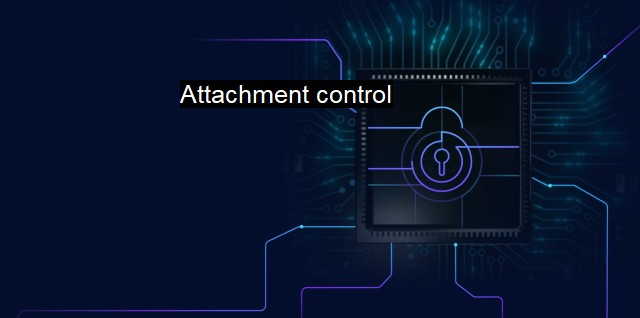What is Attachment control?
Understanding Attachment Control: The Key to Cybersecurity Against Malware and Phishing Attacks
Attachment control refers to the cybersecurity procedure of analyzing and managing MS(Musculoskeletal system) file attachments in computer systems to ensure user safety and protect system health in a hostile cyberspace environment. This concept is integral to antivirus software, the troika for reliable mechanisms to monitor, prevent, and report on cyber threats that hamper day-to-day technology-based operations.Files, web links or pictures sent via emails or instant messaging platforms aren't always safe. They can carry malware and viruses that can gain unwanted access to systems, taking away vital information or producing adverse effects which create productivity-draining bottlenecks. By conducting comprehensive checks on these attachments, attachment control prevents any threats or attacks from entering a system, securing the cyber perimeter in real-time.
It is vital to note that attachment control does not solely focus on executable or .exe files, which traditionally were most notorious for accommodating viruses and malware. Instead, it encompasses a more extensive collection of attachments, such as macro-loaded .xls, .doc, or .ppt files, to contain the ever-mutating crop of digitalized threats.
To carry out its function, an exceptionally designed antivirus software provides technology capable of scanning a wide array of attachments for potential threats. The software is specifically engineered to both identify known threats from a database and discover emergent threats leveraging intricate algorithms designed into their system. Hence, ensuring feasible protection against even the most cryptic attacks.
Significantly, attachment control also relies on solid user-behavior teaching. Users are better off leaning on the side of skepticism around emails from unknown senders or even known senders with unidentified links and attachments. This human element—appropriate digital etiquette training—is essential in repelling network breaches.
Antivirus software and systems that offer attachment control often keep a very comprehensive and constantly updated database of viruses, malware, and other malicious scripts. These potentially malicious programs are trapped inside these quarantined sectors before they spread and do the intended damage on systems. Then, once they are identified, they can be removed with effective means, therefore minimizing the potential and aftermath of the attack.
Antivirus programs are not flawless in nature and can create a negligible amount of false positives. Occasionally, safe files could also be caught in the antivirus net posing as a probable contaminant affecting efficiency. Despite the sporadic hiccups, implementing robust antivirus programming far outweighs the cons, as these could be considered as preventive measurement actions.
Attachment control functions at various levels of magnitude. At an individual level, individual users take the first gatekeeping role by deploying an antivirus system on their device that encompasses attachment control. it also finds relevance at the corporate and network level, where overseeing such attachments become more sophisticated and multi-faceted with a higher risk level, given the massive amount of data traffic to track.
Over time, attachment control as a concept has become increasingly dynamic. As cyber threats evolve, so does the architectural construct of antivirus software to tackle them more rigorously. Many modern-day antivirus software now come with advanced detection abilities to make more nuanced and accurate judgments about attachments — a testament to the progressive nature of attachment control in a cybersecurity environment.
Attachment control is one of the backbones of holistic defense in cybersecurity practice. This real-time threat detection manages digital risk and combats complicated virus outbreaks proficiently. In a digital-dependent scenario, without attachment control, threats creep into our networks, causing unpredicted turmoil. For this reason, the function of attachment control in antivirus software plays a pivotal role in our digital safety, securing cyberspace—one attachment at a time.

Attachment control FAQs
What is attachment control in cybersecurity?
Attachment control is a security feature that restricts users from downloading or opening suspicious email attachments that may contain malware and viruses. It is an essential component of antivirus software that ensures the safety of users' devices and data.How does attachment control work?
Attachment control works by scanning email attachments for tell-tale signs of malware, such as malicious scripts or executable files. If it identifies any suspicious activity, it blocks the attachment from being downloaded or opened, preventing potential harm to the user's device and data.Can attachment control be turned off?
Yes, attachment control can be turned off; however, it is not recommended to do so. Disabling attachment control makes the system more vulnerable to cyberattacks, as it leaves users unprotected against malware and viruses that may be embedded in email attachments.How important is attachment control in antivirus software?
Attachment control is a critical feature of antivirus software, as email attachments are one of the primary ways that malware and viruses can be spread. Without attachment control, users are at a much higher risk of falling victim to a cyberattack, which can result in theft of sensitive data, financial loss, and other adverse consequences.| | A | | | B | | | C | | | D | | | E | | | F | | | G | | | H | | | I | | | J | | | K | | | L | | | M | |
| | N | | | O | | | P | | | Q | | | R | | | S | | | T | | | U | | | V | | | W | | | X | | | Y | | | Z | |
| | 1 | | | 2 | | | 3 | | | 4 | | | 7 | | | 8 | | |||||||